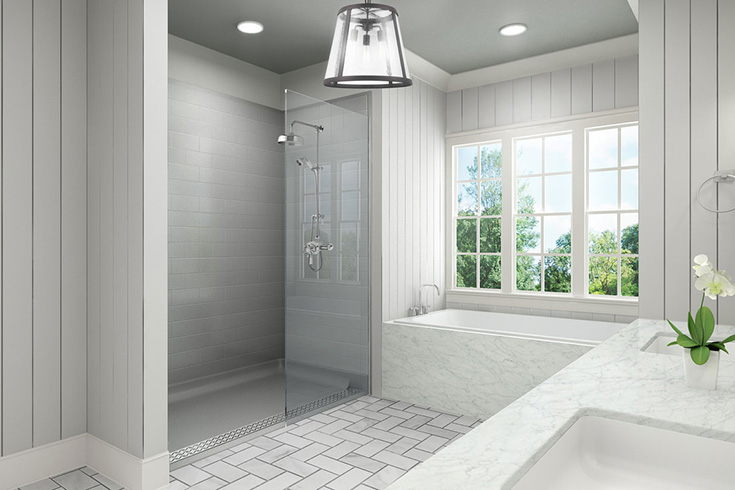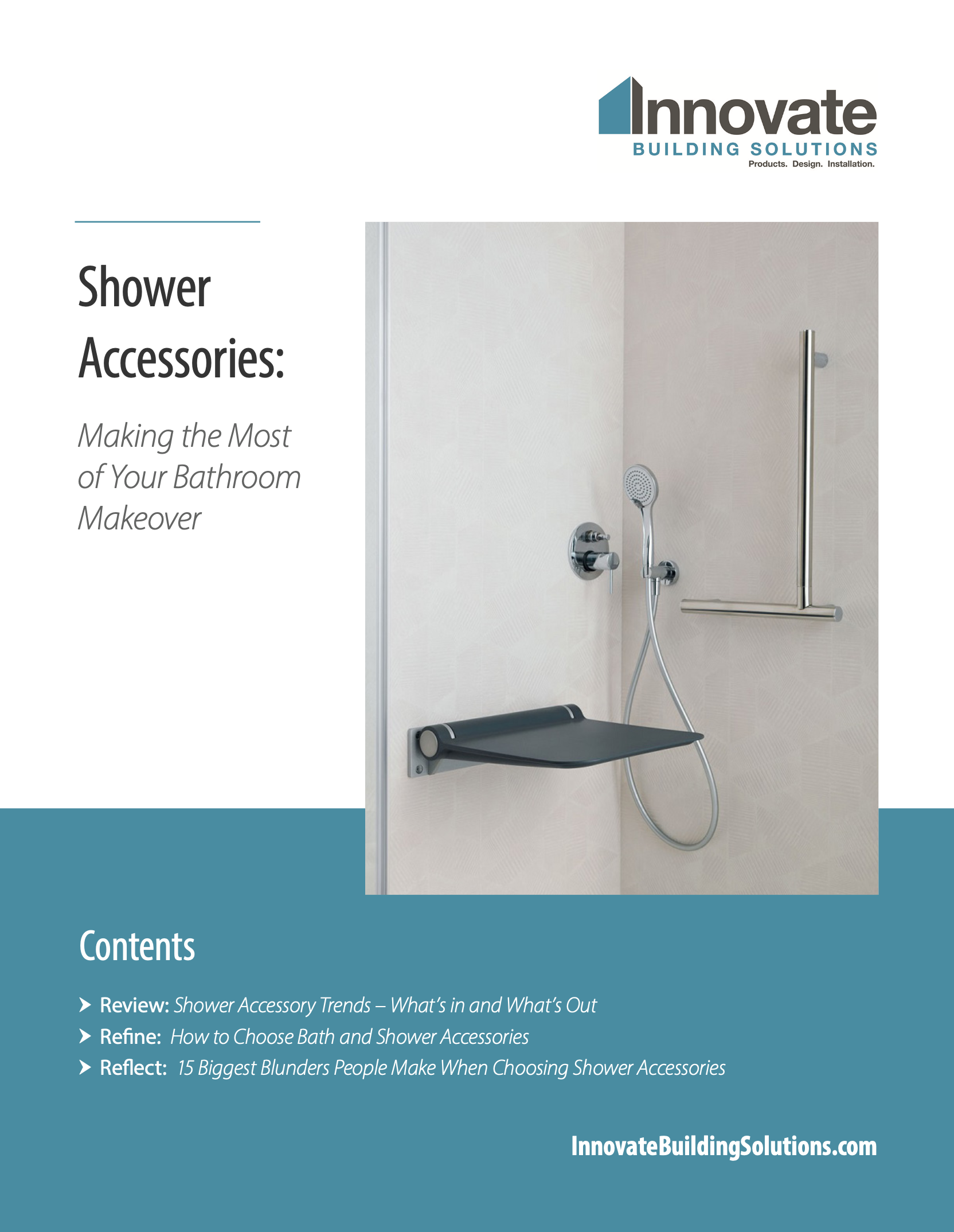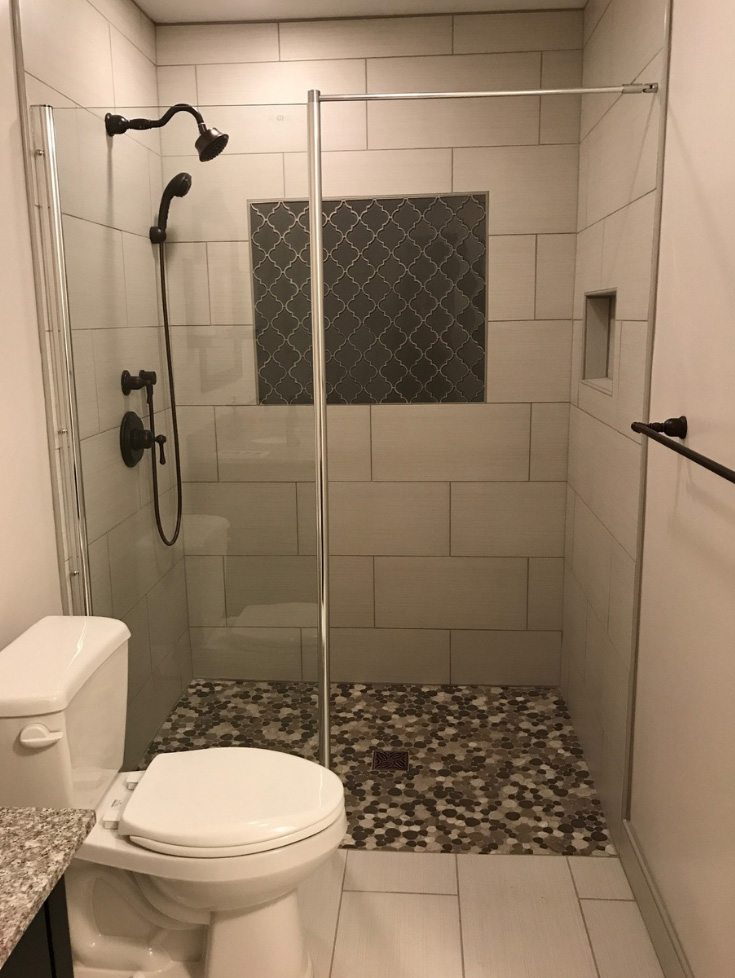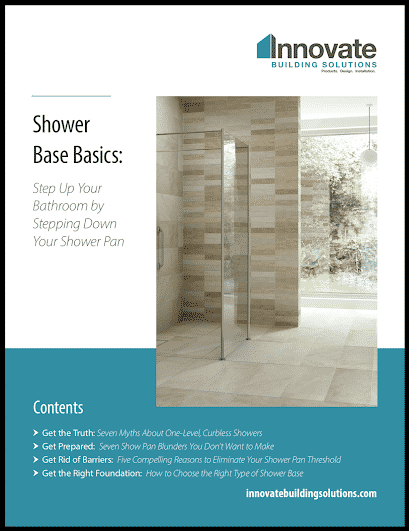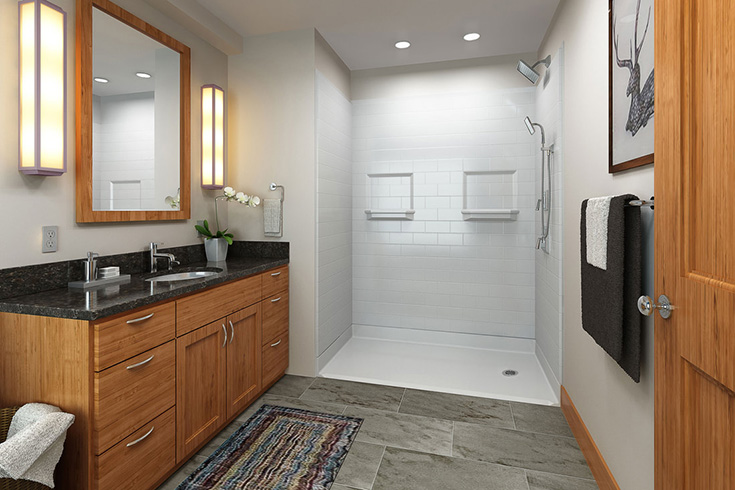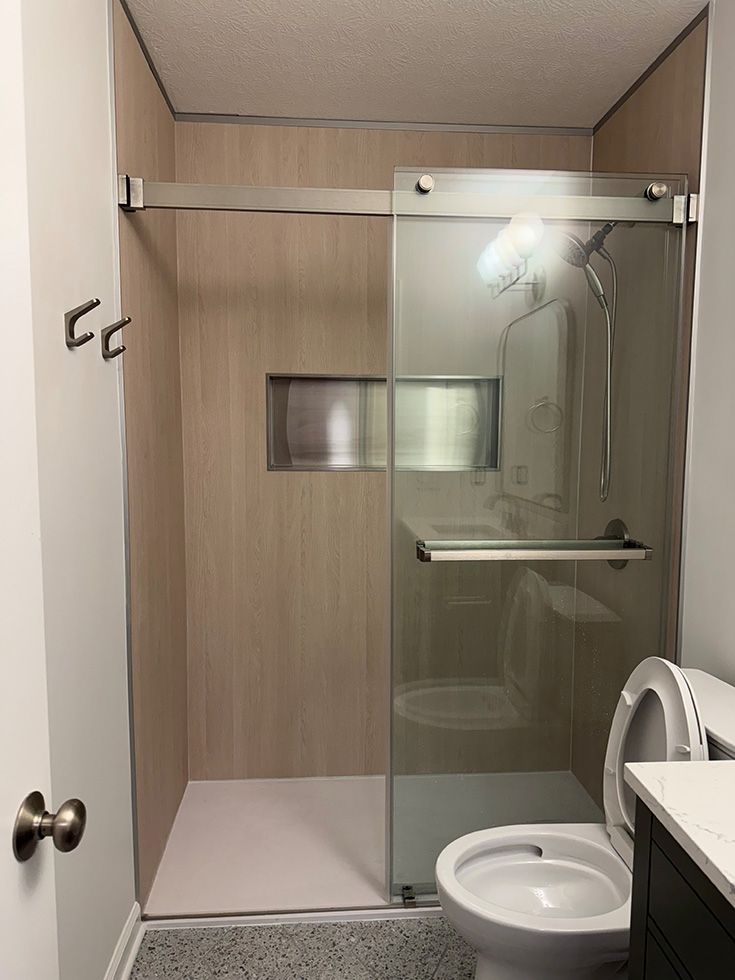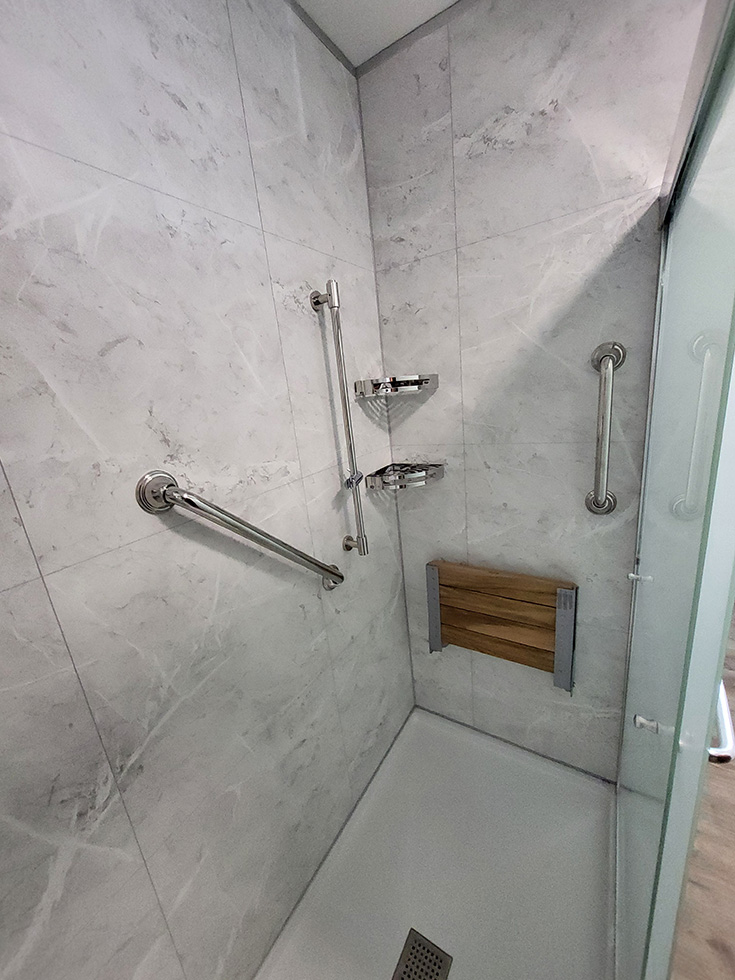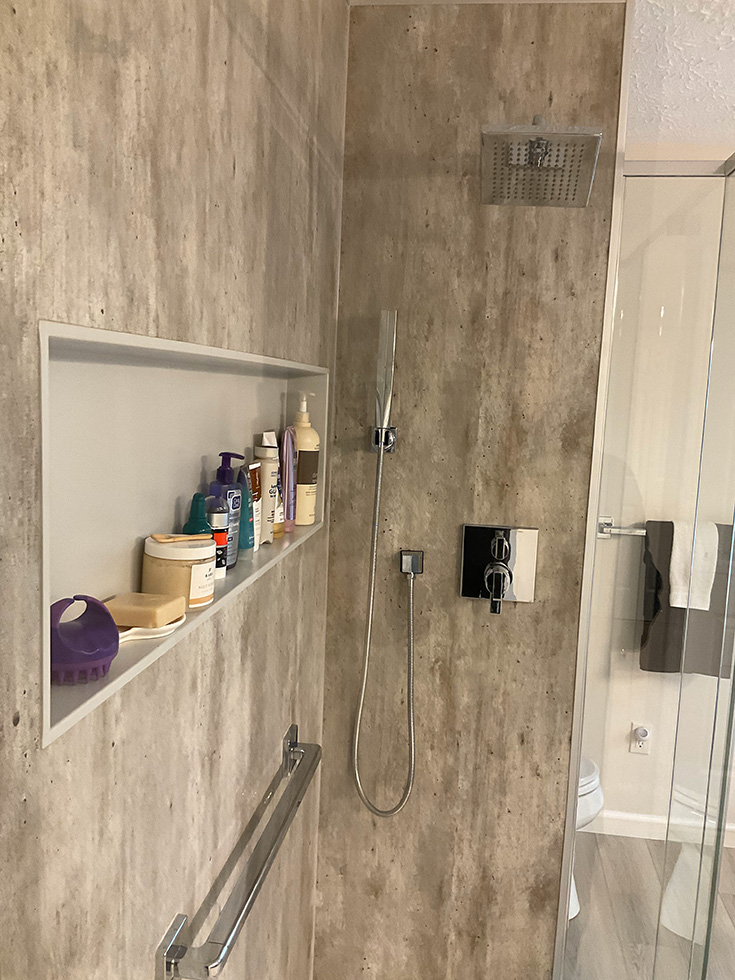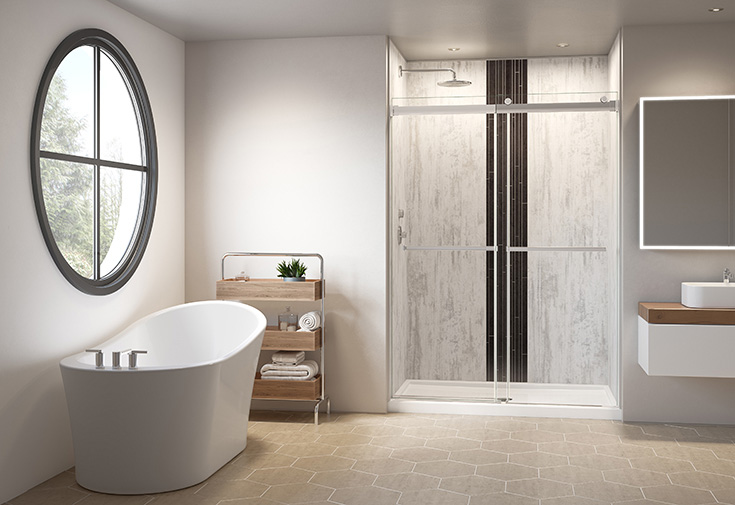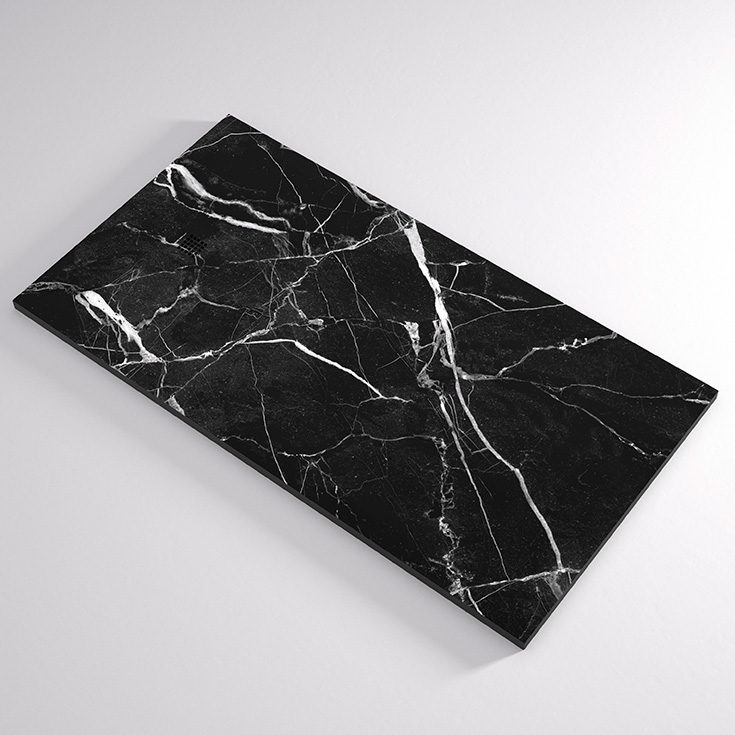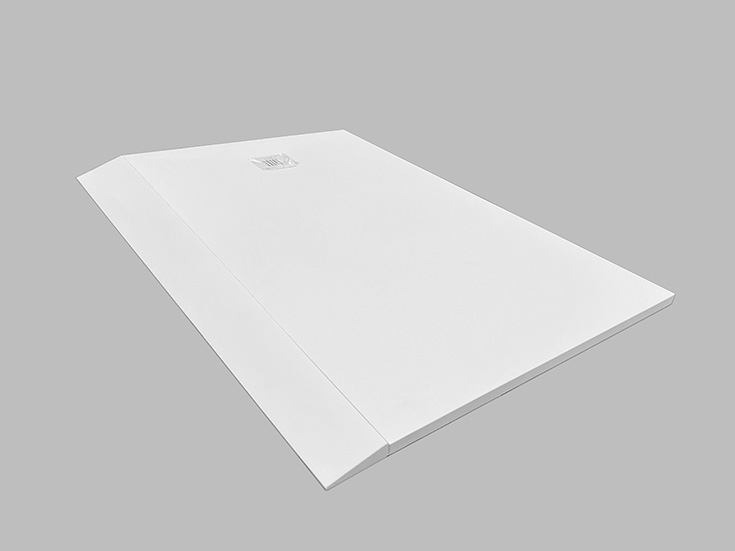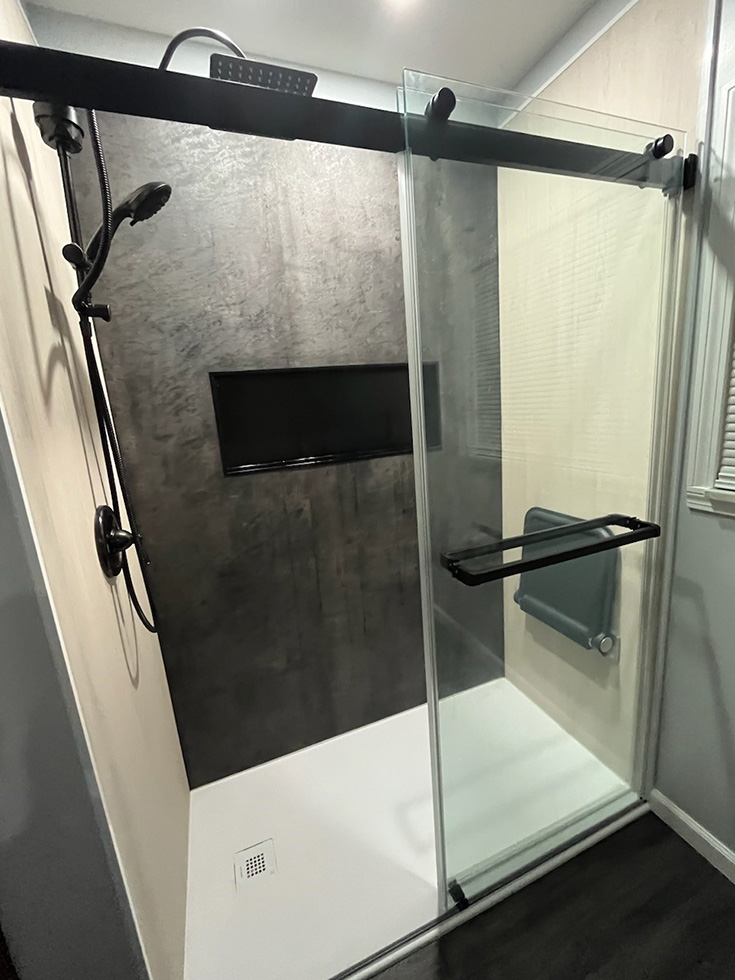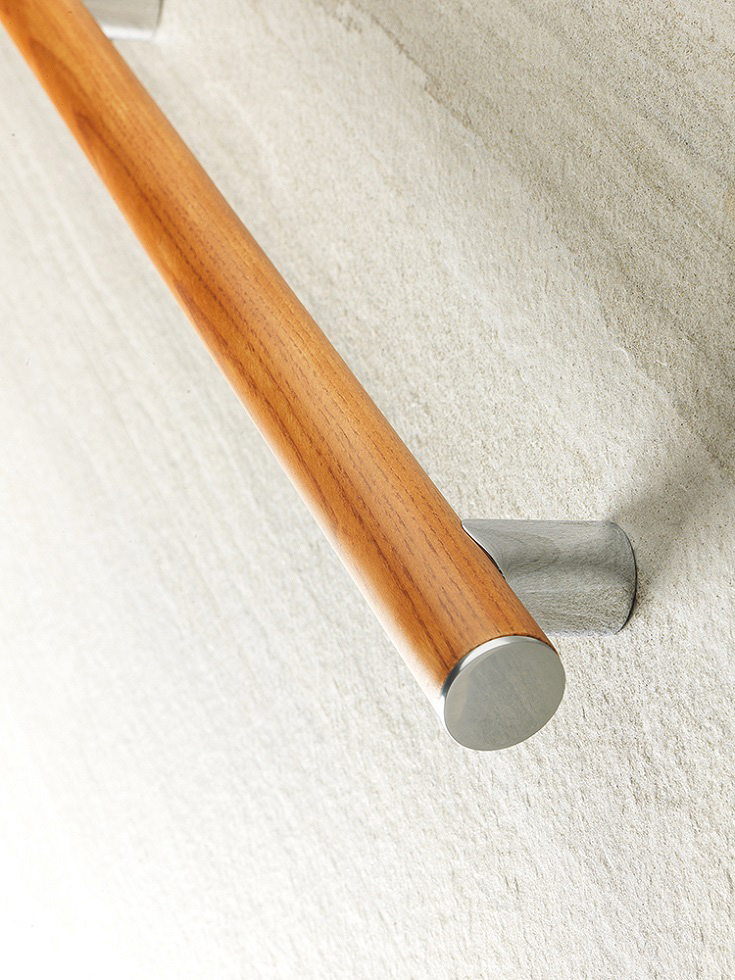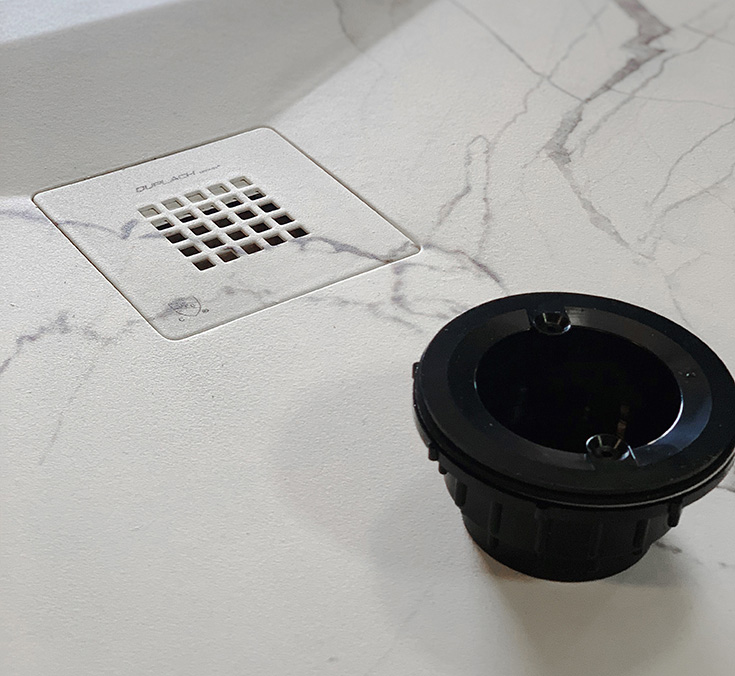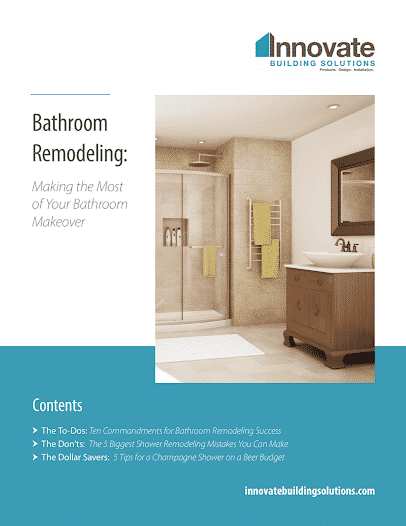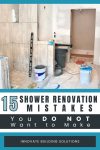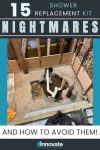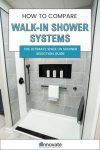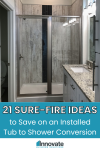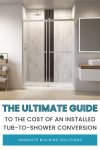How to help mom and dad get a safe shower

Maybe it’s your New Year’s resolution—or simply a must-do task you can’t put off any longer. You’ve decided it’s time to help mom and dad—or yourself—upgrade from an old bathtub to a safe, accessible roll-in or walk-in shower. This decision could be one of the smartest aging-in-place home improvements you can make.
And you know this will be no small feat.
Their desire to change is …. well…. ‘er NOT HIGH! And that’s putting it lightly. And they aren’t exactly willing to admit they aren’t as nimble as they used to be!
But you know the tub/shower unit in their bathroom is an accident waiting to happen. And after reading 80% of falls happen in the bathroom (and more elderly die from falls than from cancer), you were on a mission to eliminate this safety hazard. YOU KNOW (even if mom and dad won’t admit it) their mobility and eyesight isn’t what it used to be.
However, if you’re confused on where to begin and ‘who you’re gonna call’ (and no, Ghostbusters is NOT a good option) to help with this project, you’ve come to the right article.
Below I’ll provide 5 steps – with practical recommendations and referrals – on how to get the right products not only for a safe shower for mom and dad – but also one which is simple to maintain and stylish. In addition, I’ll also give ideas on how you’ll find the funds to pay for the job, if money IS an object for them.
So, let’s check out the steps.
Step 1 – Think about how long mom and dad will be in this home, and whether they’ll need an ‘age in place’ or ‘accessible shower.’
I know this is a hard question to ask yourself (and a bit depressing) when you’re considering a shower for mom and dad, but how long you estimate they’ll be able to live in this home (with assistance or not) will be an important determinant in thinking through how much to invest in a shower remodel or bathroom modifications (and how much funding you may need). More about this in step 4.
In addition, the other question to ask is if this will be an ‘age in place shower’ (where they’re reasonably healthy, and you’re just looking to make it safer), or conversely if they need an ‘accessible shower’ which is specifically designed to work with the physical challenges, or diagnoses you know they already have.
For an age in place shower, they’ll be a wider range of contractors capable of delivering a good result – and the product offerings you can use will be bigger also.
For an accessible shower you may need help from people in the medical community (like an Occupational Therapist) or a Home Accessibility Contractor who works closely with the medical community to design and install showers and other bathroom products for people with various challenges.
Step 2 – Identify the shower products mom and day may need for a safe shower.
The number of products you could use to ensure mom and dad are safe is extensive. However, thinking through how long they’re likely to live there (and funding available to them) can help you choose which products should be prioritized.
For example, if you need a safe shower quickly – AND you’re not anticipating they’ll stay in this home for long (and may need a higher level of care through a community facility offering assisted living or memory care sooner than later), you may want to choose lower cost products to make the bathroom safer on a budget. Minor bathroom modifications which can be installed without extensive effort and expense include:
-
- Grab bars – Grab bars make sense inside the tub/shower, getting in and out of the shower, and close to the toilet.

- A shower chair – A shower chair can be brought into and out of a tub or shower so mom and dad can shower while seated (assuming the location of the shower head makes this possible).
- A tub or shower mat – A tub or shower mat will add traction and reduce how slippery the bottom of a shower pan, or tub may be today.
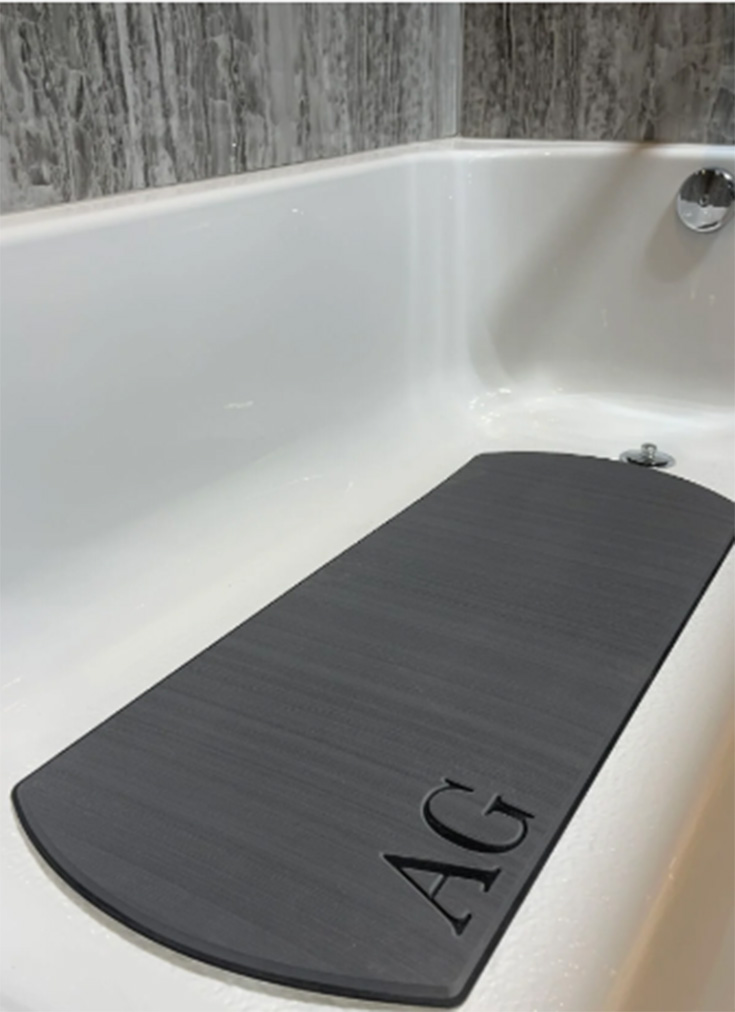
- An elevated toilet seat – Since most toilets are 15-16” tall (which is shorter than a chair around your kitchen table), it’s harder to get up from the toilet than it is from the kitchen table. Elevated toilets seats can raise the height of an existing toilet by 3 to 4”.
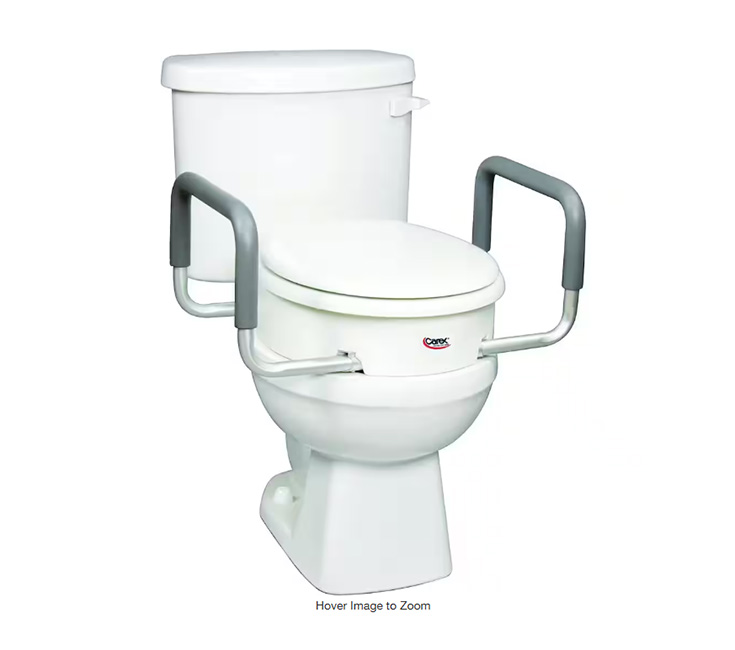
On the other hand, if they’ll be in their home a while AND need an accessible or age in place shower, options include:
- A one level shower – A one level shower is built so there’s no threshold (or curb) between the bathroom and the shower. This type of shower can be perfect if you anticipate mom, or dad will need a wheelchair or they just like the sleek look this type of shower creates. Note – this will often be a more expensive option but can even add resale value because of it’s contemporary design.
-
- A pre-built ramped shower pan – The ramped pan is specifically designed for someone who needs a wheelchair or walker. It’s simpler to install than a one level wet room because it’s set on the existing subfloor (as opposed to a one level wet room shower base former which is set on floor joists). The one consideration with the barrier free ramped pan is to understand when you go to sell their home – ramped pans have a negative impact on resale value (unless the person buying the home anticipates a family member will need a wheelchair).
- A low profile shower pan – Low profile shower pans look sleek yet are safer to enter. Low profile pans will often be less expensive than the one level shower or ramped pans discussed above and can be a desired feature for couples of all ages. And what’s nice is you can find low profile shower pans in lower priced fiberglass or acrylic materials – or more durable stone finishes (even with color and decorative marble patterns).
- Decorative grab bars – While you can get the usual (truck stop-or-hospital-style) grab bar, a smarter purchase if you anticipate mom and dad will be there a while is to buy a decorative grab bar. Today’s grab bars can look like stylish towel bars and won’t ‘scream out’ AN OLD PERSON LIVES HERE!
- A shower seat, bench seat, or transfer bench seat – Unless you have a big shower – I would stay away from bench seats because they’re big and eat up a ton of room. For most standard showers (let’s say a tub to shower conversion which is 60” x 30” or 60” x 32,” or a shower to shower conversion which is 48” x 36” or 60” x 36”) a fold down seat is a wonderful investment. It’ll not only help mom have a place to sit and shave her legs, but it’ll provide a safe place for anyone with limited mobility to shower (or for dad to shave his legs if he’s looking to join the Senior Olympic swimming team. And YES there is such a thing, and I actually know a gold medal winner who competed on this team!).
-
- Easier to maintain (and more stylish) shower wall surrounds – If your parents hate a moldy or dirty shower – and the thought of them getting on their hands and knees to ‘attempt’ to scrub brown mold off the tile joints makes you want to cringe, now is the time to fix this problem. Shower wall surrounds come in all shapes and sizes from real stone and tile (which are a pain to maintain) to grout free wall panels. And if you want them to enjoy the style of a nice looking shower – but also not have to maintain it, products like 3/8” thick laminate wall surrounds (with a lifetime warranty) can be a thing of beauty.
- Shower storage – A HUGE thing lacking in standard molded fiberglass one-piece tub/shower units is storage. And if you’re constantly picking up shampoo bottles which fall off the tiny ledges in these premade units you know what I’m talking about. And if you’re doing a tub to shower conversion it’s the perfect time to fix their storage problems – and to make the shower safer so there’s not slippery liquids oozing out on the shower pan. To save space a tall vertical – or long horizontal recessed niche or corner shelves can be just what the doctor ordered (or hopefully it’s what YOU ordered BEFORE they needed the doctor!).
- Improve lighting – What’s depressing is the eyesight of a 60 year old is 1/3 of that of a 20 year old. And this is the reason improving lighting in the shower is a smart way to make it safer. Add products like a solar wall tube, LED lighting (so they don’t have the change the lightbulb), a skylight, or a clear glass shower door (vs. a curtain) so they’re less likely to fall while getting into or out of the shower.
- Sturdier glass shower door – If you’re not going for a walk in shower (without a door) you’ll want to replace flimsy (and impossible to clean) framed shower doors with thicker glass doors with glass surface protection to protect against spotting.
Step 3 – Don’t accept UG-LY or institutional for mom and dad’s newer, safer shower!
For anyone aging (and yes, unfortunately that’s ALL of us!) it’s impossible to stop Father Time. The reality is this guy is still undefeated.
However, while mom and dad may need a safer shower – there’s no reason they have to accept an ugly and institutional shower or bathroom which reminds them of a hospital room, or a truck stop bathroom.
And what’s encouraging today – IF you know these secrets – is an accessible or age in place shower does not have to look ugly or depressing.
Make sure mom and dad’s bathroom is not only safe (which is the ‘price of admission’ for a senior bathroom), simple to use AND clean, but also stylish. Imagine hitting that trifecta! Here’s 5 ideas to take the ugly and institutional out of a safe, senior shower.
-
- Idea #1 – Use a low profile shower pan with a modern design. With todays low profile stone shower pans you can even get marble designs in pans with low (1 1/6” high) curbs which have 2 TONS of weight capacity. There’s no need to worry about this shower pan flexing or cracking even if you or a caregiver has to get in to assist them.
- Idea #2 – The ‘disappearing’ ramp – Yes, you heard this right. And this is NOT a magic trick. But if mom or dad will (or may) need a wheelchair the biggest negative you’ll have when you sell the home is getting the next buyer to want to accept a ramped shower pan (unless the prospective buyer has a wheelchair user). And if the buyer asks you to remove the ramped pan as a condition to buy your home – you’ll be looking at a BIG expense because you’ll need to redo the entire shower. However, the good news is you can get showers with ‘removable ramps.’ You can silicone the ramp kit next to the pan if you need it now – then remove it when you sell the home.
-
- Idea #3 – Stylish, yet easy to clean, grout free shower surround panels – Let’s face it, tile – which looks wonderful when it’s installed – can be a P.I.A. as the grout joints (which are porous) get dirty and moldy. And I know the problem many people have with grout free shower surround panels is many are built in a mold, made of plastic, and look cheap. If you’d love a simple to maintain shower which looks like real tile or stone – check out laminate wall panels like you’ll see below. It’s like, I Can’t Believe It’s Not Butter but for shower surround panels. But note, I doubt these panels taste as good as I Can’t Believe It’s Not Butter, although I can’t claim I’ve tried them.
- Idea #4 – Decorative grab bars – Say goodbye to truck stop grab bars. Today’s better designed grab bars don’t look like grab bars – and this improved look is to be celebrated!
- Idea #5 – Stop looking at ugly shower drains – There’s nothing quite as ugly as round pitted shower drain covers. And while I know it’s not a big detail, it’s still something which doesn’t add to the ambiance (shall I say) of a shower. Get rid of this problem with a color-matching square drain or with a shower pan with a linear drain.
Step 4 – Think about how you’ll pay for mom and dad’s bathroom modifications or complete bathroom remodel.
While minor bathroom modifications like grab bars, a shower chair, a tub or shower mat, or an elevated toilet seat are not too costly, when you need to create a new age in place or accessible shower prices go up rapidly. And if mom or dad are on a fixed income, and their savings are low, the dilemma on how to pay for more extensive bathroom modifications or a remodel are ‘for real,’ just like the teacher Mr. Garvey is in this funny Key and Peale skit below.
And as you may already know, moving into an independent or assisted living community becomes far more expensive than remodeling in just a matter of months.
So, if you’re struggling to find money to pay for this project (or for an independent or assisted living facility), and the quarters buried under the cushions of their couch aren’t going to cover it, here’s ideas to consider.
- Reverse mortgages – With a reverse mortgage, the title to the home remains in their name. There’s no mortgage payments to be made. And they can use equity in the home to pay expenses (like a bathroom remodel or monthly bills). The loan is repaid when they no longer live in the home.
- Grants – Habitat for Humanity, The Coalition for Home Repair, and Rebuilding Together are organizations who offer grants to help seniors pay for home improvement projects. For example, through the Heroes at Home Program, the national non-profit Rebuilding Together offers home modification assistance in the form of labor and material reimbursement to U.S. veterans.
- Veterans Administration – For qualifying veterans, the HISA Grant (which stands for the Home Improvements and Structural Alterations Grant) provides $6,800 in lifetime benefits. Another grant through the VA is the SAH Grant (Specially Adapted Housing) which helps qualifying veterans who have lost limbs, suffered blindness, lost the use of a lower extremities, or have severe burns. There’s also the Veterans Directed Home and Community Bases Services (VD-HCBS) program which provides financial assistance to help veterans stay in their homes.

- Home equity loans and lines of credit – These loans will let mom and dad borrow against 85% of the equity in their home.
- Medicare – In rare cases Medicare may pay for assistive technology devises which are part of a bathroom modification if they’re required for medical reasons and prescribed by a doctor.
- Medicare Advantage (MA) plans – The Centers for Medicare and Medicaid Services (CMS) allowed MA plans to offer supplemental heath benefits which can include home modifications for recipients who have a medical need. However, note these plans vary state by state.
- Medicaid Home and Community Based Services (HCBS) Waivers – These state programs offer assistance to low income seniors to live independently in their homes and avoid nursing home placement. Each state has different eligibility requirements and benefits.
- Home Improvement Loans – There are many companies (like Hearth and GreenSky to name just two) who work through bathroom remodeling, home access contractors, and home improvement companies who offer 0% credit cards, same as cash payment financing, or traditional loans for home modification and bathroom remodeling projects.
Step 5 – A wise man (or woman) knows what they don’t know. Get help designing and buying your safe shower for mom and dad!
Let’s face it – making decisions on a bath and shower remodel is hard enough – but when you throw in mom or dad’s mobility and health challenges (and budget concerns) you may be experiencing a ‘degree of difficulty’ harder than performing a reverse 4.5 somersault in the pike position (and yes, I know ALL of you may not know what that is but if you love watching diving –but nobody’s going to catch YOU on that diving board- check out the video below).
So, how can you find help to choose the right products, get assistance if funds are limited, and actually get mom and dad a shower they’ll love (because it’s safe, simple and stylish) and you’ll love because you’ll worry less? Here’s resources to consider:
- Call a professional Occupational Therapist – They’re trained to help mom and dad improve their ability to perform daily activities better despite whatever challenges they have. In addition, they also can provide insights on the right products and systems to use for your bathroom. And the cost is sometimes covered by Medicare.
- For an ‘accessible shower’ contact a home access contractor – Not all bathroom remodeling contractors understand how to design a shower for people with medical conditions. Home access contractors (these are companies who also install ramps, stairlifts, platform lifts, and grab bars) know the ins and outs to create spaces which work for people with progressive medical conditions. If you don’t know where to find these specialized contractors go to the VGM Live at Home network.
-
- For an ‘age in place shower’ look for Certified Age in Place (CAPS) contractors – Age in place contractors have experience with the products and installation approaches to make a bathroom work for everyone – from grandkids to grandparents. However, they’re usually not as knowledgeable about the impact of medical conditions and shower design as the home access contractors mentioned above.
So, are you in a better place to help mom and dad with their accessible or age in place shower?
If I did my job right in this article I’ve provided you with ideas and resources to start your journey towards a safe, simple, and stylish shower for mom and dad. And you’ll also know options (in addition to underneath the cushions of their couch) to find money to pay for the job.
And while I’ve tried to give you a good number of resources, I know this article WAS NOT talking specifically to your situation.
So, given this – I’d love to offer you personalized help.
If you’re looking for design insights, for a safe, simple, and stylish age in place or accessible shower – or referrals, call a Shower Specialist at Innovate Building Solutions at 877-668-5888 or request a Free Design Consultation
Or if you’re a bathroom contractor, a kitchen and bath showroom, or multi-unit property owner (or buyer) looking for products for accessible or age in place showers call me at 888-467-7488 or visit the wall panel dealership or multi-unit wall panel supply areas of our site.
And if you’re looking for an Akron or Cleveland age in place remodeling contractor to professionally install an accessible or age in place shower or do a tub to shower conversion, call 216-531-6085.
And lastly – thanks for reading this article – and putting up with my wacky personality. Basically, the older I get the more I like to laugh along the way as I’m dishing out advice. And if I don’t say so myself, I’m ‘for real’ just like Mr. Garvey!
The best to you (and your mom and dad) with your project,
Mike
